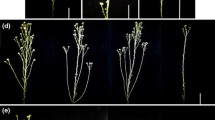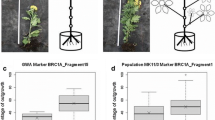Abstract
Branching is an important horticultural trait that influences plant architecture and production of cut chrysanthemum; however, its genetic determinism is poorly understood. In this study, an F1 mapping population derived from a cross between two spray cut chrysanthemum cultivars was used to determine QTL underlying branching. The branching traits in the F1 mapping population exhibited over-parent segregation and relatively high heritability (0.68–0.92). Based on the branching traits across two consecutive years, 16 additive QTL, including five QTL for primary branch number, each four QTL for branch height, and branch angle, and three QTL for primary branch length, were identified, with each accounting for 6.9–24.4 % of the phenotypic variation. Of these, four QTL expressed stable, located in the same genomic regions across two consecutive years. Results from this study add new understanding of the genetic basis of branching in spray cut chrysanthemum, and the putative major QTL detected here are valuable for future breeding cut chrysanthemum that exhibits desirable branching type.


Similar content being viewed by others
References
Boonchanawiwat A, Sraphet S, Boonseng O, Lightfoot DA, Triwitayakorn K (2011) QTL underlying plant and first branch height in cassava (Manihot esculenta Crantz). Field Crop Res 121:343–349
Comstock RE, Robinson HF (1948) The components of genetic variance in populations of biparental progenies and their use in estimating the average degree of dominance. Biometrics 4:254–266
Domagalska MA, Leyser O (2011) Signal integration in the control of shoot branching. Nat Rev Mol Cell Biol 12:21–25
Doust AN, Kellogg EA (2006) Effect of genotype and environment on branching in weedy green millet (Setaria viridis) and domesticated foxtail millet (Setaria italic) (Poaceae). Mol Ecol 15:1335–1349
Doust AN, Devos KM, Gadberry MD, Gale MD, Kellogg EA (2004) Genetic control of branching in foxtail millet. Proc Natl Acad Sci 101:9045–9050
Finlayson SA, Krishnareddy SR, Kebrom TH, Casal J (2010) Phytochrome regulation of branching in Arabidopsis. Plant Physiol 152:1914–1927
Fregene M, Okogbenin E, Mba C, Angel F, Suarez MC, Janneth G, Chavarriga P, Roca W, Tohme J, Bonierbale M, Tohme J (2001) Genome mapping in cassava improvement: challenges achievements and opportunities. Euphytica 120:159–165
Huh EJ, Lee YR, Choi SY, Do KR, Pak CH (2007) Genotypic differences of axillary budding in response to temperature and ethephon treatment in non-branching chrysanthemums. Hortic Environ Biotechnol 48:370–375
Huh YJ, Lim JH, Park SK, Choi SR, Kim SH, Pak CH (2011) Endogenous indole-3-acetic acid and trans-zeatin ribosides in relation to axillary bud formation in standard chrysanthemum. Hortic Environ Biotechnol 52:128–132
Huh YJ, Han BH, Park SK, Lee SY, Kil MJ, Pak CH (2013) Inhibition of chrysanthemum axillary buds via transformation with antisense tomato Lateral Suppressor gene is season dependent. Hortic Environ Biotechnol 54:280–287
Jiang B, Miao H, Chen S, Zhang S, Chen F, Fang W (2010) The Lateral Suppressor-like gene, DgLsL, alternated the axillary branching in transgenic chrysanthemum (Chrysanthemum × morifolium) by modulating IAA and GA content. Plant Mol Biol Report 28:144–151
Kosambi DD (1944) The estimation of map distances from recombination values. Ann Eugen 12:172–175
Li C, Wang C, Dong N, Wang X, Zhao H, Converse R, Xia Z, Wang R, Wang Q (2012) QTL detection for node of first fruiting branch and its height in upland cotton (Gossypium hirsutum L.). Euphytica 193:441–451
Lincoln SE, Daly MJ, Lander ES (1993) Constructing genetic linkage maps with Mapmaker/EXP version 3.0 and mapping genes controlling quantitative traits using Mapmaker/QTL, version1.1. A tutorial and reference manual. Whitehead Institute for Biomedical Research, Cambridge, MA
McCouch SR, Chen X, Panaud O, Temnykh S, Xu Y, Cho YG, Huang N, Ishii T, Blair M (1997) Microsatellite marker development, mapping and applications in rice genetics and breeding. Plant Mol Biol 351:89–99
McSeen P (2009) Hormonal regulation of branching in grasses. Plant Physiol 149:46–55
Müller O, Leyser O (2011) Auxin, cytokinin and the control of shooting branching. Ann Bot 107:1203–1212
Murray M, Thompson WF (1980) Rapid isolation of high molecular weight plant DNA. Nucleic Acids Res 8:4321–4325
Okamoto A, Suto K (2003) Morphological observation on viable and nonviable axillary bud formation in non-branching chrysanthemum ‘Iwanohakusen’. J Jpn Soc Hortic Sci 72:422–424
Paterson AH, Damon S, Hewitt JD, Zamir D, Rabinowitch HD, Lincoln SE, Lander ES, Tanksley SD (1991) Mendelian factors underlying quantitative traits in tomato: comparison across species, generations, and environments. Genetics 127:181–197
Peng H, Chen F, Fang W, Jiang J, Chen S, Guan Z, Liao Y (2013) Heterosis and mixed genetic analysis of branch traits of cut chrysanthemum. Acta Hortic Sinica 40:1327–1336 (in Chinese with English abstract)
Robbins MD, Casler MD, Staub JE (2008) Pyramiding QTL for multiple lateral branching in cucumber using inbred backcross lines. Mol Breed 22:131–139
Schmitz G, Theres K (2005) Shoot and inflorescence branching. Curr Opin Plant Biol 8:506–511
Schoellhorn RK, Barrett JE, Nell TA (1996) Branching of chrysanthemum cultivars varies with season, temperature, and photosynthetic photon flux. HortScience 31:74–78
Schoellhorn RK, Barrett JE, Bartuska CA, Nell TA (2001) Elevated temperature affects axillary meristem development in Dendranthema × grandiflorum ‘Improved Mefo’. HortScience 36:1049–1052
Shin HK, Choi SY, Joung HY (2003) Inheritance and variation of nonbranching habit in chrysanthemum. Acta Hortic 620:245–252
Sun Z, Liu P, Li J, Meng X, Zhang X (2008) Construction of a genetic linkage map in Fenneropenaeus chinensis (Osbeck) using RAPD and SSR markers. Hydrobiologia 596:133–141
Voorrips RE (2002) MapChart: software for the graphical presentation of linkage maps and QTLs. J Hered 93:77–78
Wang S, Basten JC, Zeng ZB (2007) Window QTL Cartographer Version 2.5. Statistical genetics. North Carolina State University, USA
Wang H, Jiang J, Chen S, Qi X, Peng H, Li P, Song A, Guan Z, Fang W, Liao Y, Chen F (2013) Next-generation sequencing of the Chrysanthemum nankingense (Asteraceae) transcriptome permits large-scale unigene assembly and SSR marker discovery. PLoS One 8:e62293
Xu Z, Zou F, Vision TJ (2005) Improving quantitative trait loci mapping resolution in experimental crosses by the use of genotypically selected samples. Genetics 170:401–408
Zeng ZB (1994) Precision mapping of quantitative trait loci. Genetics 136:1457–1468
Zhang F, Chen S, Chen F, Fang W, Li F (2010) A preliminary genetic linkage map of chrysanthemum (Chrysanthemum morifolium) cultivars using RAPD, ISSR and AFLP markers. Sci Hortic 125:422–428
Zhang F, Chen S, Chen F, Fang W, Deng Y, Chang Q, Liu P (2011a) Genetic analysis and associated SRAP markers for flowering traits of chrysanthemum (Chrysanthemum morifolium). Euphytica 177:15–24
Zhang F, Chen S, Chen F, Fang W, Chen Y, Li F (2011b) SRAP-based mapping and QTL detection for inflorescence-related traits in chrysanthemum (Dendranthema morifolium). Mol Breed 27:11–23
Zhang F, Jiang J, Chen S, Chen F, Fang W (2012) Mapping single-locus and epistatic quantitative trait loci for plant architectural traits in chrysanthemum. Mol Breed 30:1027–1103
Acknowledgments
This program was financially supported by the National Nature Science Foundation of China (Grant Nos. 31272196, 31370699, 31372092), 863 Project by Ministry of Science and Technology of China (2011AA100208), the Ministry of Education Support Program for New Century Excellent Talents of China (NCET-12-0890), the Jiangsu Program for Hi-Tech Research (Grant Nos. BE2011325, BE2012350), Fund for Independent Innovation of Agricultural Sciences in Jiangsu Province [CX(12)2020], and the Fundamental Research Funds for the Central Universities (KYTZ201401).
Author information
Authors and Affiliations
Corresponding author
Rights and permissions
About this article
Cite this article
Peng, H., Zhang, F., Jiang, J. et al. Identification of quantitative trait loci for branching traits of spray cut chrysanthemum. Euphytica 202, 385–392 (2015). https://doi.org/10.1007/s10681-014-1259-1
Received:
Accepted:
Published:
Issue Date:
DOI: https://doi.org/10.1007/s10681-014-1259-1




